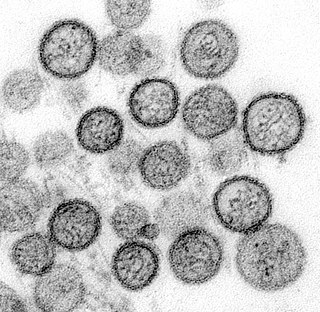
Orthohantavirus is a genus of single-stranded, enveloped, negative-sense RNA viruses in the family Hantaviridae within the order Bunyavirales. Members of this genus may be called orthohantaviruses or simply hantaviruses.
Seoul orthohantavirus (SEOV) is a member of the Orthohantavirus family of rodent-borne viruses and is one of the 4 hantaviruses that are known to be able to cause Hantavirus hemorrhagic fever with renal syndrome (HFRS). It is an Old World hantavirus; a negative sense, single-stranded, tri-segmented RNA virus.
Puumala orthohantavirus (PUUV) is a species of Orthohantavirus. Humans infected with the virus may develop a haemorrhagic fever with renal syndrome (HFRS) known as nephropathia epidemica. Puumala orthohantavirus HFRS is lethal in less than 0.5% of the cases. Rarely, PUUV infection can cause Guillain-Barré syndrome.
Amur virus (AMRV) is a zoonotic negative-sense single-stranded RNA virus. It may be a member of the genus Orthohantavirus, but it has not be definitively classified as a species and may only be a strain. It has been identified as a causative agent of hemorrhagic fever with renal syndrome.
Sangassou orthohantavirus(SANGV) is single-stranded, negative-sense RNA virus species of the genus Orthohantavirus in the Bunyavirales order. It was first isolated in an African wood mouse in the forest in Guinea, West Africa in 2010. It is named for the village near where the mouse was trapped. It is the first indigenous Murinae-associated African hantavirus to be discovered.

Hantavirus hemorrhagic fever with renal syndrome (HFRS) is a group of clinically similar illnesses caused by species of hantaviruses. It is also known as Korean hemorrhagic fever and epidemic hemorrhagic fever. It is found in Europe, Asia, and Africa. The species that cause HFRS include Hantaan orthohantavirus, Dobrava-Belgrade orthohantavirus, Saaremaa virus, Seoul orthohantavirus, Puumala orthohantavirus and other orthohantaviruses. Of these species, Hantaan River virus and Dobrava-Belgrade virus cause the most severe form of the syndrome and have the highest morbidity rates. When caused by the Puumala virus, it is also called nephropathia epidemica. This infection is known as sorkfeber in Swedish, myyräkuume in Finnish, and musepest in Norwegian.

Hantavirus pulmonary syndrome (HPS) is one of two potentially fatal syndromes of zoonotic origin caused by species of hantavirus. These include Black Creek Canal virus (BCCV), New York orthohantavirus (NYV), Monongahela virus (MGLV), Sin Nombre orthohantavirus (SNV), and certain other members of hantavirus genera that are native to the United States and Canada.
Dobrava-Belgrade orthohantavirus (DOBV), also known as Dobrava virus, is an enveloped, single-stranded, negative-sense RNA virus species of Old World Orthohantavirus. It is one of several species of Hantavirus that is the causative agent of severe Hantavirus hemorrhagic fever with renal syndrome. It was first isolated in 1985 from a yellow-necked mouse found in the village of Dobrava, southeastern Slovenia. It was subsequently isolated in striped field mice in Russia and other parts of Eastern Europe. It has also been found in Germany but the reservoir host there is unknown.
Soochong virus (SOOV) is a zoonotic negative sense single-stranded RNA virus. It may be a member of the genus Orthohantavirus, but it has not be definitively classified as a species and may only be a strain. It is one of four rodent-borne Hantaviruses found in the Republic of Korea. It is the etiologic agent for Hantavirus hemorrhagic fever with renal syndrome (HFRS). The other species responsible for HFRS in Korea are Seoul virus, Haantan virus, and Muju virus.
Monongahela virus (MGLV) is a single-stranded, negative-sense Orthohantavirus virus of zoonotic origin that causes hantavirus pulmonary syndrome.
Tula orthohantavirus, formerly Tula virus, (TULV) is a single-stranded, negative-sense RNA virus species of orthohantavirus first isolated from a European common vole found in Central Russia. It causes Hantavirus hemorrhagic fever with renal syndrome. The Microtus species are also found in North America, Europe, Scandinavia, Slovenia, Asia, and Western Russia. Human cases of Tula orthohantavirus have also been reported in Switzerland and Germany.
Hantaan orthohantavirus (HTNV) is an enveloped, single-stranded, negative-sense RNA virus species of Old World Orthohantavirus. It is the causative agent of Korean hemorrhagic fever in humans. It is named for the Hantan River in South Korea, and in turn lends the name to its genus Orthohantavirus and family Hantaviridae.
Topografov virus is an enveloped, negative-sense RNA virus of the genus Orthohantavirus in the Bunyavirales order. It is the first hantavirus to be isolated from Siberian lemmings found near the Topografov River in the Taymyr Peninsula, Siberia.
Imjin thottimvirus(MJNV) is a single-stranded, enveloped, negative-sense RNA virus of the orthohantavirus genus in the Bunyavirales order. It is a newly identified hantavirus isolated from the lung tissues of Ussuri white-toothed shrews of the species Crocidura lasiura captured near the demilitarized zone in the Republic of Korea during 2004 and 2005.
Choclo orthohantavirus (CHOV) is a single-stranded, negative-sense RNA zoonotic New World hantavirus. It was first isolated in 1999 in western Panama. The finding marked the first time Hantavirus pulmonary syndrome (HPS) was found in Central America.
Nova virus is a single-stranded, negative-sense, enveloped RNA virus with a trisegmented genome. It is one of the most divergent lineages of the hantavirus group – zoonotic viruses of the family Bunyaviridae. No known human cases of infection have yet been reported
Rockport virus (RKPV) is a single-stranded, enveloped, negative-sense RNA orthohantavirus.
Serang virus(SERV) is a single-stranded, negative-sense, enveloped, novel RNA orthohantavirus.
Gou virus (GOUV) is a single-stranded, negative-sense, enveloped novel RNA orthohantavirus. It is one of the known hantaviruses responsible for hantavirus hemorrhagic fever with renal syndrome in humans.
Hantavirus vaccine is a vaccine that protects in humans against hantavirus infections causing hantavirus hemorrhagic fever with renal syndrome (HFRS) or hantavirus pulmonary syndrome (HPS). The vaccine is considered important as acute hantavirus infections are responsible for significant morbidity and mortality worldwide. It is estimated that about 1.5 million cases and 46,000 deaths occurred in China from 1950 to 2007. The number of cases is estimated at 32,000 in Finland from 2005 to 2010 and 90,000 in Russia from 1996 to 2006.


